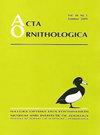濒危穴居小月牙胸海雀的繁殖生物学
IF 1.3
4区 生物学
Q3 ORNITHOLOGY
引用次数: 0
摘要
摘要对许多鸟类来说,繁殖的成功可能与筑巢地点的可用性有关,特别是在生态专业的洞穴筑巢鸟类中。对于洞穴筑巢物种来说,选择合适的基质可能是成功繁殖的基础。小新月胸Puffbird Malacoptila minor是一种分布有限的海滨鸟,分布在巴西东北部的马拉尼昂州和皮亚伊州。它是唯一一个被列为濒临灭绝的海滨,人们对它的自然历史知之甚少。在三个繁殖季节(2017年至2020年)共发现49个巢穴。巢穴由在地里挖出的洞穴组成,这些洞穴只用于繁殖一次。孵化期为21.2±1.3天,孵化期为19.5±2.9天。巢里有两三个蛋。平均孵化率为0.46±0.47个蛋/窝,繁殖力为1.0羽/雌。根据梅菲尔德的方案,每个巢的幼鸟产量为0.53只,明显的繁殖成功率为22.4%(N=49),为15.7%(N=49%)。每个时期繁殖成功的概率在孵化阶段比在筑巢阶段更大。捕食被确定为巢穴失败的主要原因(77.5%),主要发生在孵化阶段。确认了三种捕食者:食蟹狐狸Cerdocyon thou、火蚁Solenopsis saevissima和蜥蜴Common Tegu Salvator meriane。繁殖季节从雨季开始,巢穴泛滥似乎并不令人担忧,这与其他海滨的现有数据形成了鲜明对比。本研究的结果是关于小新月胸蟾蜍繁殖生物学的第一批数据,代表着对蟾蜍科繁殖模式的理解取得了重要进展。本文章由计算机程序翻译,如有差异,请以英文原文为准。
Breeding Biology of the Endangered Burrow-Nesting Lesser Crescent-Chested Puffbird Malacoptila minor
Abstract. For many birds breeding success may be related to the availability of nesting sites, particularly in ecologically specialized cavity-nesting birds. For burrow-nesting species, the selection of an appropriate substrate may be fundamental to a successful breeding attempt. The Lesser Crescent-chested Puffbird Malacoptila minor is a bucconid with a restricted distribution, which is found in the states of Maranhão and Piauí, in northeastern Brazil. It is the only bucconid listed as threatened with extinction, and little is known about its natural history. A total of 49 nests were found over three breeding seasons (2017–2020). Nests consist of burrows dug in the ground that are used only once for breeding. Incubation lasted 21.2 ± 1.3 days and the nestlings fledged after 19.5 ± 2.9 days. The nests contained two or three eggs. The mean hatching rate was 0.46 ± 0.47 eggs per nest and the fecundity rate was 1.0 fledgling per female. The production was 0.53 fledglings per nest, apparent reproductive success was 22.4% (N = 49), and was 15.7% (N = 49) when based on Mayfield's protocol. The probability of breeding success per period was greater during the incubation phase than during the nestling phase. Predation was identified as the principal cause of nest failure (77.5%), mainly during the incubation phase. Three predators were identified: the Crab-eating Fox Cerdocyon thous, the fire ant Solenopsis saevissima, and a lizard, the Common Tegu Salvator merianae. Breeding season starts with the onset of rainy season and nest flooding did not appear to be a concern, which contrasts with the available data on other bucconids. The results of the present study are the first data on the breeding biology of the Lesser Crescent-chested Puffbird, and represent an important advance in the understanding of breeding patterns in the Bucconidae.
求助全文
通过发布文献求助,成功后即可免费获取论文全文。
去求助
来源期刊

Acta Ornithologica
生物-鸟类学
CiteScore
2.10
自引率
0.00%
发文量
14
审稿时长
>12 weeks
期刊介绍:
Publishes scientific papers (original research reports, reviews, short notes, etc.) and announcements from all fields of ornithology. All manuscripts are peer-reviewed.
Established in 1933 as Acta Ornithologica Musei Zoologici Polonici, since 1953 continued under the present title.
Published twice a year by the Natura Optima Dux Foundation under the auspices of the Museum and Institute of Zoology, Polish Academy of Sciences.
 求助内容:
求助内容: 应助结果提醒方式:
应助结果提醒方式:


